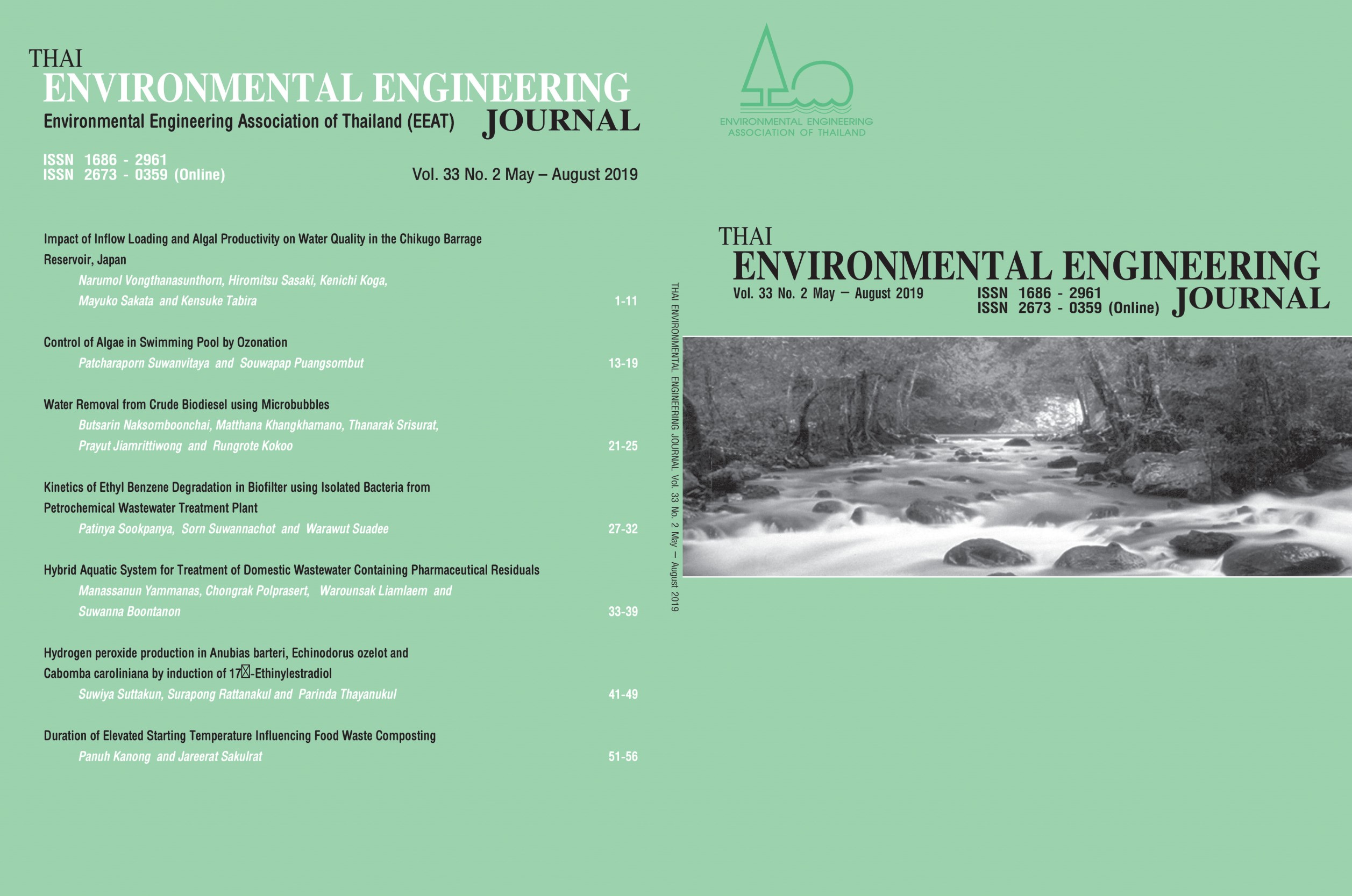Impact of Inflow Loading and Algal Productivity on Water Quality in the Chikugo Barrage Reservoir, Japan
Main Article Content
Abstract
The Chikugo Barrage is located at 23 km upstream from the mouth of the Chikugo River, which is the largest river in the Northern Kyushu Region of Japan. Main purposes of the Chikugo Barrage are flood control, water supply, maintaining flow of the Chikugo River and preventing seawater intrusion from the Ariake Sea. There are two rivers flowing into the reservoir, the Chikugo River (main stream) and the Homan River (a tributary). According to the intake of water supply and irrigation water, and the operation of the Chikugo Barrage, previous researches reported that the hydraulic retention time (HRT) in the reservoir of the Chikugo Barrage became longer and resulted in high growth of phytoplankton in the reservoir during 1985-2008. In this study, relationship between loading from upstream, HRT and algal productivity on water quality in the Chikugo Barrage Reservoir was analyzed by using water quality model. Calculated results confirm that chlorophyll-a (Chl-a) in the reservoir increased when inflow loading was high or when the HRT in the reservoir was long. Algal productivity significantly affected on the nutrient level and also led to the increase in COD and SS in the reservoir. Without loading from the Homan River, simulated result of COD in the reservoir becomes lower which indicates that loading from the Homan River has subsidiary impact on algal growth in the reservoir. Loading control in the Homan River Basin is suggested as an effective measure for water quality management in the Chikugo Barrage Reservoir.
Article Details
References
http://www.fao.org/nr/water/aquastat/data/query/index.html Access: July 15, 2019.
[2] The Secretariat of the Headquarters for Water Cycle Policy: White Paper of Water Cycle FY2018
https://www.kantei.go.jp/jp/singi/mizu_junkan/pdf/h30_mizujunkan_shisaku.pdf
[3] River Bureau, Ministry of Land, Infrastructure and Transport (2006). Rivers in Japan.
[4] Ministry of Land, Infrastructure, Transport and Tourism (2008). Water Resources in Japan. http://www.mlit.go.jp/tochimizushigen/mizsei/water_resources/index.html Access: July 15, 2019.
[5] Rutger De Graaf and Fransje Hooimeijer (edited). 2015. Urban Water in Japan. Taylor & Francis/Balkema, Leiden.
[6] Chikugo Barrage Operation and Maintenance Office, Incorporated Administrative Agency Japan Water Agency (2015). Chikugo Barrage.
[7] Ministry of Land, Infrastructure, Transport and Tourism. Water Resources Development Basic Plan.
http://www.mlit.go.jp/tochimizushigen/mizsei/english/d_plan/plan02.html
Access: March 31, 2019.
[8] Japan Water Agency: Technologies https://www.water.go.jp/honsya/honsya/english/about/technologies.html
Access: July 15, 2019.
[9] Vongthanasunthorn, N., Koga, K., Araki, H. et. al. Characteristics of water quality and pollutant load analysis in Chikugo River. At Inter-Regional Symposium on Sustainable Development (ISSD), Thailand 1999.
[10] Vongthanasunthorn, N., Koga, K., Araki, H. and Liengcharernsit, W. Simulation models for water resources management in Chikugo River basin. In: Brebbia, C.A., Anagnostopoulos, P., Katisfarakis, K. et al. Water Resources Management, WIT Press, 2001; 89-98.
[11] Vongthanasunthorn, N., Koga, K., Araki, H. and Masaki, A. Water quality analysis in Chikugo River, At Annual Conference of JSCE, Japan. 2002 (in Japanese).
[12] Yamaguchi, H., Koga, K., Dong, D. Basic study on behavior of algae in the Chikugo Barrage Reservoir. At Annual Conference of JSCE, Japan. 2009 (in Japanese).
[13] Shigemura, Y. 2013. Research on characteristics of algal productivity in the Chikugo Barrage Reservoir. Report of Graduate Research, Saga University.
[14] Sakata, M., Vongthanasunthorn, N., Sasaki, H. and Koga, K. Research on changes in algal productivity in the Chikugo Barrage Reservoir. At Annual Conference of Japan Society of Civil Engineers (Western Region) at Miyazaki University, Miyazaki, Japan on March 3, 2018 (in Japanese).
[15] Tabira, K., Vongthanasunthorn, N., Sasaki, H. and Koga, K. Basic study on characteristics of water quality in the Homan River. At Annual Conference of Japan Society of Civil Engineers (Western Region) at Saga University, Saga, Japan on March 4, 2018 (in Japanese).
[16] Rich, L.G. 1973. Environmental System Engineering. McGraw-Hill.
[17] Chapra, S. C. 1997. Surface Water-Quality Modeling. McGraw-Hill.


